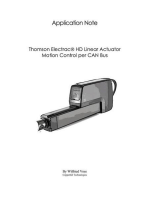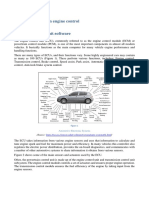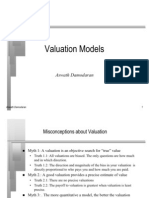Universal Tester For Electronic Control Units in Automotives
Universal Tester For Electronic Control Units in Automotives
Uploaded by
pbollaganiCopyright:
Available Formats
Universal Tester For Electronic Control Units in Automotives
Universal Tester For Electronic Control Units in Automotives
Uploaded by
pbollaganiOriginal Title
Copyright
Available Formats
Share this document
Did you find this document useful?
Is this content inappropriate?
Copyright:
Available Formats
Universal Tester For Electronic Control Units in Automotives
Universal Tester For Electronic Control Units in Automotives
Uploaded by
pbollaganiCopyright:
Available Formats
Innovative Conference on Embedded Systems, Mobile Communication and Computing (ICEMC2) 2011 Proceedings published by International Journal of Computer
Applications (IJCA)
Universal Tester for Electronic Control Units in Automotives
Jayashree Hegde,
Aeronautical Development Establishment, Bangalore, India
Rajeshwari Hegde
BMS College of Engineering, Bangalore, India
ABSTRACT
Electronics plays a major role in Modern Automobiles. Several Electronic Control Units (ECU) are employed to improve the performance of the Vehicle resulting in Lower Emissions, Reduced Fuel consumption, Increased safety, Improved drivability and last but not least better driving comfort. In general an ECU is a micro-controller based embedded system with the hardware and software suitably designed for the application. ECU interfaces with various sensors and actuators for real-time data acquisition and control. Electronic Control Unit (ECU) has ability to carry out self-diagnostics , according to a pre-defined logic and store the result in a non-volatile (EEPROM) fault memory. ECU software provides the possibility to perform diagnostics and read the result of selfdiagnostics at the service station without dismantling the electrical and electronic systems. This is done by using a Tester connected to a serial line provided by the ECU. We have developed a Tester which reads the information from the ECU and stores it in the error memory of the ECU. In this paper, we explain a PC based simulator of a real life Tester which is refereed as Universal Tester Simulator (UTS) in this article. This is to ensure ECU development is not hampered due to non availability of an actual tester.
EEPROM (for end-of-line settings and storage of faults detected by self-diagnostics). Discrete components (like Resistors and Capacitors etc.).
A mechanism to allow reading of Information from the ECU in order to localize a problem of a complex system is of high importance in the workshop. This communication goes on a special line called as K-Line [2]. Using this, the service personnel can read out the error memory of the ECU (which has the encoded information of all the failures registered in the system during operation). International Standards have been established to define common requirements for diagnostic systems. The standard is based on the Open Systems Interconnection (O.S.I.) Basic Reference Model in accordance with ISO standard 7498. Most of the ECUs support a standard serial communication protocol called as Keyword Protocol 2000(KWP2000). ISO 14229 standards specify the common requirements for implementation of diagnostic services. KWP200 protocol has specifications for the physical layer, data link layer and application layer as follows. ISO 14230-1 Specification Keyword Protocol 2000:Physical Layer
General Terms
Automotive Electronics
ISO 14230-2 Keyword Protocol 2000:Data Link Layer Specification ISO 14230-3 Keyword Protocol 2000:Application Layer Specification [3]. In spite of the above mentioned standardization efforts, due to historical reasons considerable difference exists in the actual protocol used by the various Vehicle manufacturers. Difference is mainly found in upper layers (Data Link and Application Layers) though all of them follow the ISO specifications for the physical layer. Vehicle manufacturers develop their own Testers (Normally a dedicated hand held hardware device) to support the protocol variant used by them. Whenever ECU software is developed to suit the requirements of individual Vehicle manufacturer, the same is to be tested using a suitable tool. The paper is organized as follows. Section 2 describes ECU and Interfaces. Section 3 looks at the need for a tester. Section 4 explains the design methodology. Section 5 gives the implementation details. The paper is concluded in section 6.
Keywords: ECU, CAN, K-Line, tester. 1. INTRODUCTION
Increased Use of Electronic Control Units (ECUs) boosts Demand for ECU Testers. Electronic content in present-day automobiles is constantly increasing, creating the need for ECUs that process the information obtained from different sensors in a vehicle and pass it on to actuators. This, in turn, is expected to lead to a corresponding rise in demand for ECU test equipment, which is becoming increasingly important due to the highly critical nature of various vehicle functions such as engine control, anti-lock brake system (ABS), and air bag deployment[1]. Following are the important building blocks of an Electronic Control Unit (ECU): Micro-controller with ROM, RAM. Software embedded in the EPROM. ADCs and Digital ports (interfaces for Analog and Digital inputs and outputs). Interfaces for communication with other devices (CAN, KLine etc). Special control ICs.
2.
ECU AND INTERFACES
The Universal Tester Simulator (UTS) is to be used for testing of the ECU (Electronic Control Unit) Software. In this section a brief introduction to ECU and related components is provided. Figure1 gives an overview of the Major components of a typical ECU used for Fuel Injection Control. Diagram shows major functional blocks of the ECU along with External Interfaces.
29
Innovative Conference on Embedded Systems, Mobile Communication and Computing (ICEMC2) 2011 Proceedings published by International Journal of Computer Applications (IJCA)
Fig1: Schematic Diagram of Engine Control Unit light, or MIL, if a problem was detected but would not provide any information as to the nature of the problem. Modern self diagnostic implementations use a standardized fast digital communications port to provide real-time data in addition to a standardized series of diagnostic trouble codes, or DTCs, which allow one to rapidly identify and remedy malfunctions within the vehicle. A. Main functionalities of a diagnostic Tester Reading stored ECU fault codes, giving a fast health check on the cars electronic systems. Actuator tests allow the operator to energise various actuators in the car as required to assist with fault finding. Clearing stored fault codes after the fault has been rectified. Reset the idle speed of some models. Activates diagnosis of the sub components of the ECUs. End customers (Vehicle Manufacturers) normally develop a dedicated hardware tool for K-Line interface in the form of a hand-held Tester [5]. In this paper, we explain the design of a PC based system to simulate this hardware device as closely as possible for Laboratory tests of ECU software. Mechanical Engine tester is used at the service station for the diagnostics of faults in vehicle.
As can be seen in the Schematic Diagram above, the ECU communicates with the external world through a Diagnostic interface. One of the standard features of such interface is the support for serial diagnostic line providing interface to the diagnostic Tester. The serial line used for this purpose is known as ISO K-Line and is specified by ISO 14230-1 standards [4].
2.1 ECU in a Vehicle
Fig. 2 shows a closed ECU typically used in a Vehicle and also external components, which interface with ECU. Here the ECU is completely sealed in water/air tight container and any diagnostics of the system is possible only through the K-Line interface.
4. DESIGN METHODOLOGY
Fig2: Electronic Control Unit Design Methodology followed is similar to standard structured design. The total system is sub-divided into three main components as listed below PC based software with a well-designed GUI (Graphical User Interface) for configuration of the communication and processing the results of the communication. Embedded software on the configurable tester for coordination of communication with PC including detection and correction of communication errors and relaying back the results to the PC. Embedded software on the configurable tester for execution of final commands and communication with
3. NEED FOR A TESTER
In a vehicle service station, self-diagnostic and reporting capability give the repair technician access to state of health information for various vehicle sub-systems. The amount of diagnostic information available via diagnostic Tester has varied widely since the introduction in the early 1980s of on-board vehicle computers or ECUs. Early instances of self diagnostic would simply illuminate a malfunction indicator
30
Innovative Conference on Embedded Systems, Mobile Communication and Computing (ICEMC2) 2011 Proceedings published by International Journal of Computer Applications (IJCA) the target ECU. This component also stores the result of communication in a ring buffer. method used for initialisation differs significantly in different protocols. The System should be able to simulate any such Initialisation sequence. Fast / 5 Baud Initialisation for KWP2000 OR any customer defined initialization sequence). Timings for both transmission and reception (both Inter-byte and inter-frame timings). Frame structure with respect to header bytes and Checksum etc., Support all possible Baud rate within an allowed range.
4.1 Key Design Objectives
To design a system that can simulate a Tester (Used by Vehicle manufacturer in the Service stations) in all respects. The system should support KWP2000 and any other serial (single line) communication protocol on K-Line. The system should consist of PC-based software interfacing with a configurable Tester. The PC communicates with the Tester for configuring the communication protocol and the communication parameters. The Tester communicates with the ECU and for all practical purposes behaves similar to the Tester used by end customer (Vehicle manufacturer). To summarize, the aim of the design is to develop a system where any customer defined protocol can be supported without changing the embedded software of the configurable tester. Entire configuration of the protocol should be possible through set of configuration files and Menu options on the PC based software.
4.2.2
Reliability
Tools should be able to simulate the customer Tester as close as possible. Test of the ECU software with this tool should ensure adherence to all the protocol parameters such as baud rate, Inter byte and Inter Block timings.
4.2.3 Expandability
Command set should be easily expandable. With minor modification in PC based software, it should be possible to provide Tailored Menu interfaces for simulating Testers from different vehicle manufacturers.
4.2 Design Considerations
The following are the key considerations addressed in the design.
4.2.4
Ease of Use
It should be possible to configure the tester so that it can satisfy varied protocols through simple menu options in the front-end and/or a set of commands in configuration file(s).
4.2.1
Functionality
4.3 Design Overview
Working of this tool can be schematically represented in fig3.
Tool (PC Based front End + Configurable Universal Tester H/W) should be able to simulate customer tester in all the following aspects Initialisation sequence. (An ECU needs to be initialised in-order to start a Diagnostic Session with it. The
with Configurable Tester
Interface to PC to
interface User Communication
Tester communication
Interface with Target ECU
Serial Interface Configuration/ Command-Data Exchange
PC based Software
interface
K-Line interface (Configurable Protocol)
ECU
Configurable Tester
Fig3:Block schematic of the tester
31
Innovative Conference on Embedded Systems, Mobile Communication and Computing (ICEMC2) 2011 Proceedings published by International Journal of Computer Applications (IJCA) Software is designed both for the PC based front-end as well as for Universal-Tester. Scope of the work includes development of PC based software and design and simulation of Universal Tester software. Front-end has to be developed to work on Windows based system and provides user interfaces through Menu-options and a set of dialog boxes. The software is designed to be able to read and take appropriate actions based on the commands stored in configuration file(s). Selection of configuration file(s) should be possible through Menu-Options.
6. CONCLUSION
In this paper, Universal tester for testing the ECU has been presented. ECU stores several information like Sensor Failure, and other abnormalities in a non-volatile memory. In Service stations it is possible to read this information using the Diagnostic Tester. The protocol used for the communication between the Diagnostic Tester and the ECU differs significantly across the Vehicle manufacturers. Whenever an ECU software is modified to support the customer specific protocol over K-Line interface the same can be tested using UTS. This avoids the delay in development due to non availability of the actual Tester. The tool will also help to Test the ECU software more completely with respect to every aspect of the specification like Various initialization methods and timing parameters.
4.3.1
The basic features on the PC side
PC-based user-friendly front-end for basic operation of the system Specifying the configuration of the communication protocol through user-friendly front-end and transferring the same to the Tester. Sending commands to the Tester to perform various services (including configuration). Receiving data from the Tester and displaying/storing the results of communication.
7. REFERENCES
[1] Jochen Schaffnit, Stefan Sinsel, Rolf lsermann, Hardwarein-the-loop simulation for the investigation of truck diesel injection systems, Proceedings of the American Control Conference, Philadelphia, 1998, 498-502. [2] Global Automotive ECU Functional Test Equipment Market Research, Trends, Analysis.htm. [3] International Organisation for Standards, available at www.iso.org/iso/iso_catalogue/catalogue_tc/catalogue_deta il.htm?csnumber=55591 [4] [5] freescale, available http://www.freescale.com/files/BRAUTOSOL.pdf at
4.3.2 The software features embedded on the tester
Communication with the PC to receive the configuration of the communication protocol and store it in memory. Execution of commands sent by the PC. Communication with the ECU over the K line. Configuration of the communication is decided by commands received from PC based front-end. Transfer of data received from ECU to the PC on request.
CDX Online eTextbook, available at http://www.cdxetextbook.com/toolsEquip/toolsEquip.html
The Tester is a microcontroller based system with embedded software to fulfill features described in section 1. Communication of the tester with the ECU is completely configurable and supports various timing parameters including zero inter-byte time. Scope of the work includes design of the complete system, development of PC based software also defining the communication between the PC and the Tester. The same is well defined and implemented as an API to allow future expansion of commands. The command set defined is flexible enough to handle different types of initialization, complete range of timing parameters and various header formats.
[4] ABS Troubleshooting for Trucks, Trailers, and Buses, availabl at http://www.abstroubleshooting.com/absdiagnostic-tools.html [6] Minsheng Wang. National Instruments LabVIEW Basic I . Beijing: Publishing House of Electronics Industry, 2002. [7] David J. Kruglinski, Scot Wingo, George Shepherd, Programming Microsoft Visual C++ 6.0. Beijing:Beijing Hope Electronic Press, 1999. [9] CAN in Automation, available at www.can-cia.org.
5. IMPLEMENTATION
PC based front end has been implemented using Microsoft VC++ as a Win 32 Application. This portion of software performs following operations. Provides user interface through a set of Menu Options. Handles communication interface to Configurable Universal Tester.
5.1 Implementation of Tester software
A simulation software was developed to test the proper working of PC based front-end. Simulation was done using a second PC with the serial port connection between the two PCs. (with an RS232 compatible interface). After verifying the result of simulation, Communication interface was developed on the Tester. The communication between the PC based front end and Tester was verified for correctness of timings and data.
32
You might also like
- Hypothyroidism: Progressive Weight Gain and Decreased AppetiteDocument5 pagesHypothyroidism: Progressive Weight Gain and Decreased AppetiteKrisianne Mae Lorenzo Francisco100% (2)
- 2018 Training Prospectus External Print PDFDocument48 pages2018 Training Prospectus External Print PDFJosè Manuel Coronado Saucedo0% (1)
- Electronic Control Unit (ECU) : Ankul GuptaDocument20 pagesElectronic Control Unit (ECU) : Ankul Guptadarkim ajahNo ratings yet
- Siemens MS43 SystemsDocument26 pagesSiemens MS43 SystemszefrenchNo ratings yet
- UDS Protocol Implementation in Automotiv PDFDocument6 pagesUDS Protocol Implementation in Automotiv PDFMinhaj NaimNo ratings yet
- Abstruse GooseDocument216 pagesAbstruse GoosenavtejNo ratings yet
- 1 What's Your Story?: Unit Opener PageDocument84 pages1 What's Your Story?: Unit Opener PageMounir AngadNo ratings yet
- Gowda2019 ECU Inter - Processor Data CommunicationDocument11 pagesGowda2019 ECU Inter - Processor Data Communications.b.v.seshagiri1407No ratings yet
- Diagnosis For in Vehicle NetworksDocument26 pagesDiagnosis For in Vehicle NetworksSayyedNo ratings yet
- Thomson Electrac HD Linear Actuator Motion Control per CAN BusFrom EverandThomson Electrac HD Linear Actuator Motion Control per CAN BusNo ratings yet
- Bosch Ic cg902 903 904Document8 pagesBosch Ic cg902 903 904SaadNo ratings yet
- Ob Di I Data InterpretationDocument8 pagesOb Di I Data InterpretationMohamed WahiebNo ratings yet
- On Board DiagnosticsDocument52 pagesOn Board Diagnosticsjayasundar100% (1)
- Designs of Input and Output Driver Circuits For 16-Bit Electronic Control Unit (Ecu) and Development of Control Strategy For Ecu Using These I o Driver CircuitsDocument5 pagesDesigns of Input and Output Driver Circuits For 16-Bit Electronic Control Unit (Ecu) and Development of Control Strategy For Ecu Using These I o Driver CircuitsesatjournalsNo ratings yet
- FF EcuDocument9 pagesFF EcuEduardo J CondeNo ratings yet
- Wheel Speed Sensors. Function, Diagnosis and Troubleshooting PDFDocument12 pagesWheel Speed Sensors. Function, Diagnosis and Troubleshooting PDFmadhan100% (4)
- Bosch M7.4.4 Me7.4.4 EobdDocument66 pagesBosch M7.4.4 Me7.4.4 EobdGustavo Burbano100% (2)
- User Guide: Tachosoft Online Mileage CalculatorDocument22 pagesUser Guide: Tachosoft Online Mileage CalculatorMarcelo DecimaNo ratings yet
- Replace Capacitors On EcuDocument9 pagesReplace Capacitors On EcuHomar Mur100% (4)
- Ecu Manual PDFDocument23 pagesEcu Manual PDFFERNANDO ANDRIOTTI VICENTIN0% (1)
- Fgtech BDM User Manual CarDocument43 pagesFgtech BDM User Manual Carfrancisca19No ratings yet
- 2001 Kia Optima Fuel SystemDocument136 pages2001 Kia Optima Fuel SystemJorge EspinoNo ratings yet
- Injector and Ignition Driver For Automotive ApplicationsDocument25 pagesInjector and Ignition Driver For Automotive ApplicationsAnonymous 4IEjoc100% (3)
- Diesel Control ECU Operator ManualDocument21 pagesDiesel Control ECU Operator ManualThug LabNo ratings yet
- Sensors in AutomobilesDocument18 pagesSensors in Automobilesapi-1998994992% (13)
- 93 Diagnostika PDFDocument24 pages93 Diagnostika PDFJose Antonio Jimenez Alvarez100% (1)
- CAN BusDocument32 pagesCAN BusMohammed AsharNo ratings yet
- VeCo12 3 Diagnostics 1 Geffers LectureDocument24 pagesVeCo12 3 Diagnostics 1 Geffers LecturesenthilleeNo ratings yet
- How Does GM EPS (Electric Power Steering) WorkDocument4 pagesHow Does GM EPS (Electric Power Steering) Workmhulot100% (1)
- 05 EcusDocument27 pages05 EcusJavier100% (5)
- Automotive ElectronicsDocument100 pagesAutomotive ElectronicsanushkaNo ratings yet
- Design of ECU PDFDocument51 pagesDesign of ECU PDFdada100% (5)
- CAT Questions and AnswersDocument11 pagesCAT Questions and AnswersglovictshubNo ratings yet
- Introduction To Reading An EEPROM: OscillatorDocument5 pagesIntroduction To Reading An EEPROM: OscillatorJorge Antonio Guillen100% (1)
- En Automotive Auto Electric Basic Technology Part1Document36 pagesEn Automotive Auto Electric Basic Technology Part1Calligraphie D'un CicatriceNo ratings yet
- Microprocessor Applications in Manufacturing: Control Systems in AutomobilesDocument23 pagesMicroprocessor Applications in Manufacturing: Control Systems in AutomobilesRohit GothwalNo ratings yet
- 89p303 Touareg Electronic Diesel Control EDC 16 Design and FunctionDocument55 pages89p303 Touareg Electronic Diesel Control EDC 16 Design and Functioneduardorojas007100% (1)
- End To End Information About CANBUSDocument18 pagesEnd To End Information About CANBUSjasmine100% (2)
- Mobydic 4910Document8 pagesMobydic 4910Alexking1985No ratings yet
- Programator Carprog V8.21 Online - Citire Cod Radio Airbag Reset, ECU Chip TunningDocument1 pageProgramator Carprog V8.21 Online - Citire Cod Radio Airbag Reset, ECU Chip Tunningoffice worldNo ratings yet
- Lambda Sensors: Quick and Easy Testing and ReplacementDocument12 pagesLambda Sensors: Quick and Easy Testing and ReplacementChinh HuuNo ratings yet
- InternshipDocument45 pagesInternshipPrakashRaiNo ratings yet
- LIN TrainingDocument46 pagesLIN TrainingThiago DomingosNo ratings yet
- Automotive Cable and Wiring SystemDocument20 pagesAutomotive Cable and Wiring SystemBala100% (1)
- Automotive Diagnostics Communication Protocols AnalysisKWP2000, CAN, and UDSDocument12 pagesAutomotive Diagnostics Communication Protocols AnalysisKWP2000, CAN, and UDSInternational Organization of Scientific Research (IOSR)0% (1)
- Design of Automotive Instrument Cluster Based On OSEK StandardDocument5 pagesDesign of Automotive Instrument Cluster Based On OSEK StandardQui PhuNo ratings yet
- Diganostcs For Automobiles-A SnapshotDocument8 pagesDiganostcs For Automobiles-A SnapshotZeljkoSipcicNo ratings yet
- Internal Combustion Engine Control 1. Engine Control Unit SoftwareDocument10 pagesInternal Combustion Engine Control 1. Engine Control Unit SoftwareLahcen KhalifNo ratings yet
- UDS Protocol Implementation in An ECUDocument6 pagesUDS Protocol Implementation in An ECULayon Bruno100% (4)
- Self-Diagnostic Signal Monitoring System of KWP2000 Vehicle ECUDocument6 pagesSelf-Diagnostic Signal Monitoring System of KWP2000 Vehicle ECUAutoLoungeSANo ratings yet
- RepairDiagnostics PT 01 C0G36Z008E 3MBDocument6 pagesRepairDiagnostics PT 01 C0G36Z008E 3MBJosé Da Silva MataNo ratings yet
- DiagnosticsDocument13 pagesDiagnosticsAlbert BhattiNo ratings yet
- AUTOSAR 3.2 Based Protocol Data Unit Router ModuleDocument6 pagesAUTOSAR 3.2 Based Protocol Data Unit Router ModuleEditor IJRITCCNo ratings yet
- Basic of Automotive DiagnosisDocument88 pagesBasic of Automotive Diagnosisjimmy mlelwaNo ratings yet
- Iit KharagpurDocument39 pagesIit KharagpurBhupendra KharpuseNo ratings yet
- Function and Software Development For Ecus: Cover StoryDocument6 pagesFunction and Software Development For Ecus: Cover StorypetrishiaNo ratings yet
- On Board Diagnostic SystemDocument31 pagesOn Board Diagnostic SystemMuhammad Nazmi100% (1)
- ETACS Functinality Development For The OUTLANDERDocument5 pagesETACS Functinality Development For The OUTLANDERcartronix2010No ratings yet
- PV776 88983801Document24 pagesPV776 88983801stephane richard meyemNo ratings yet
- A PROJECT REPORT ON Electronic Voting MachineDocument97 pagesA PROJECT REPORT ON Electronic Voting Machinereddu143No ratings yet
- Software DLB International Manual Del UsuarioDocument131 pagesSoftware DLB International Manual Del UsuarioJuan Rivera100% (1)
- Eng-Design of Open Architecture Ship-M.S. ZaghloulDocument18 pagesEng-Design of Open Architecture Ship-M.S. ZaghloulImpact JournalsNo ratings yet
- (CPG) Acute Myeloid Leukemia National Clinical Practice GuidelinesDocument91 pages(CPG) Acute Myeloid Leukemia National Clinical Practice GuidelinesKai ChuaNo ratings yet
- 500hp Parameter PDFDocument122 pages500hp Parameter PDFcaressessNo ratings yet
- MethodologyDocument19 pagesMethodologyreyesmarquis6uNo ratings yet
- ESG Data SheetDocument62 pagesESG Data SheetJOSAYA MUSICNo ratings yet
- United States Patent: (10) Patent No.: (45) Date of PatentDocument12 pagesUnited States Patent: (10) Patent No.: (45) Date of PatentKhaidir WijayaNo ratings yet
- Ugovor o ZakupuDocument2 pagesUgovor o ZakupuMarina NikačNo ratings yet
- Important Tables For Sap SDDocument142 pagesImportant Tables For Sap SDkarthikbjNo ratings yet
- Canadian Infantry School AOFP Results BriefingDocument39 pagesCanadian Infantry School AOFP Results BriefingJesseKentNo ratings yet
- Agricultural Produce Export Act Cap-319Document36 pagesAgricultural Produce Export Act Cap-319mark oneNo ratings yet
- The Washington Post - Year 144 Issue 283 (14 Sep 2021)Document56 pagesThe Washington Post - Year 144 Issue 283 (14 Sep 2021)Xplosion01No ratings yet
- Assignment 7 Solution 3rd EditionDocument5 pagesAssignment 7 Solution 3rd EditionAvi SinghNo ratings yet
- Vaj CortecDocument6 pagesVaj CortecvenkateshbitraNo ratings yet
- TM 2020 CLD 604 U. B. Chemicals V Ahmed NawazDocument16 pagesTM 2020 CLD 604 U. B. Chemicals V Ahmed NawazPleader BoyNo ratings yet
- TS TetDocument3 pagesTS TetKonakala RajeshNo ratings yet
- Achieve Higher Distillation Efficiency When Using A Rotary EvaporatorDocument10 pagesAchieve Higher Distillation Efficiency When Using A Rotary EvaporatorAbdulwahid SultanNo ratings yet
- Alex Coghe's Street Photography GuideDocument77 pagesAlex Coghe's Street Photography GuideAlexCoghe100% (5)
- Lesson 1.2 Conversion of Units and Error AnalysisDocument21 pagesLesson 1.2 Conversion of Units and Error AnalysisAiona MenorNo ratings yet
- Oce - 7050-TSMDocument275 pagesOce - 7050-TSMrameshpatel857100% (5)
- Eagle 72HM G5 JKM520 540M 72HL4 V F1 Us 2Document2 pagesEagle 72HM G5 JKM520 540M 72HL4 V F1 Us 2sifran5555No ratings yet
- Tata Tech SummerDocument2 pagesTata Tech Summermadanmohan573No ratings yet
- Gravity FlowDocument11 pagesGravity FlowAnonymous U18LFvdfD100% (4)
- Work Questions For PracticeDocument2 pagesWork Questions For PracticelolyNo ratings yet
- Tasks - Data Science Fresher Position @NeenOpalDocument3 pagesTasks - Data Science Fresher Position @NeenOpalBannu RohithNo ratings yet
- Uk Postcode County MapDocument1 pageUk Postcode County MapPrav SidhuNo ratings yet
- Laboratory Experiment No.4 RULA Assessment Method Name: Embile, MonethDocument9 pagesLaboratory Experiment No.4 RULA Assessment Method Name: Embile, MonethAubrey RamiloNo ratings yet
- Valuation ModelsDocument47 pagesValuation ModelsAshwin Kumar100% (1)
- 60A Hybrid ManualDocument4 pages60A Hybrid ManualBook BerryNo ratings yet

























































































